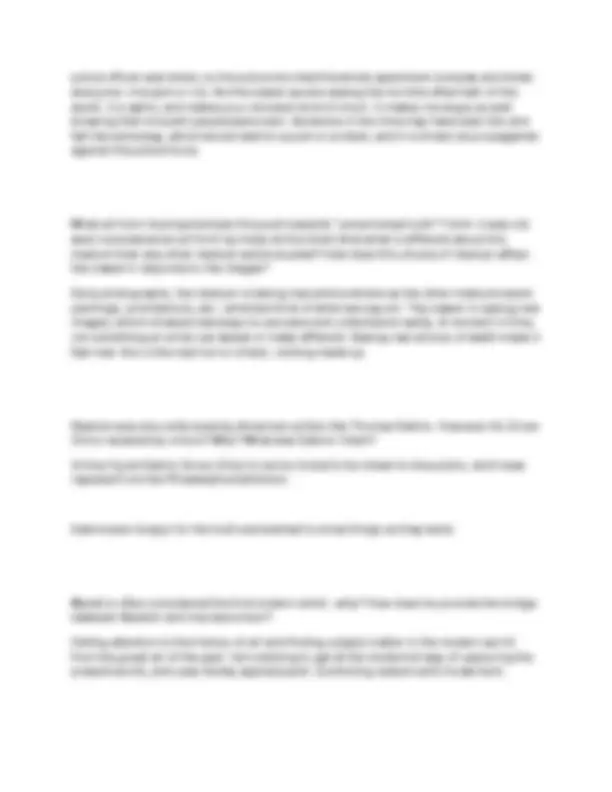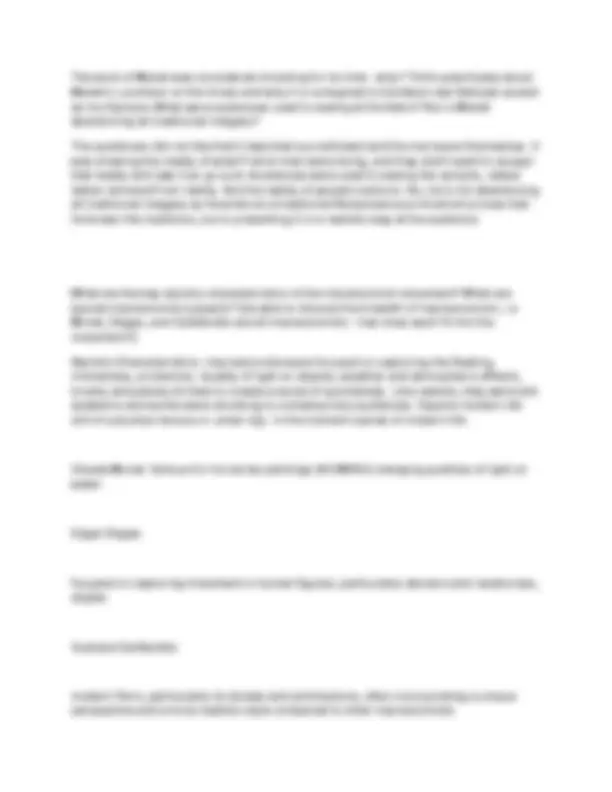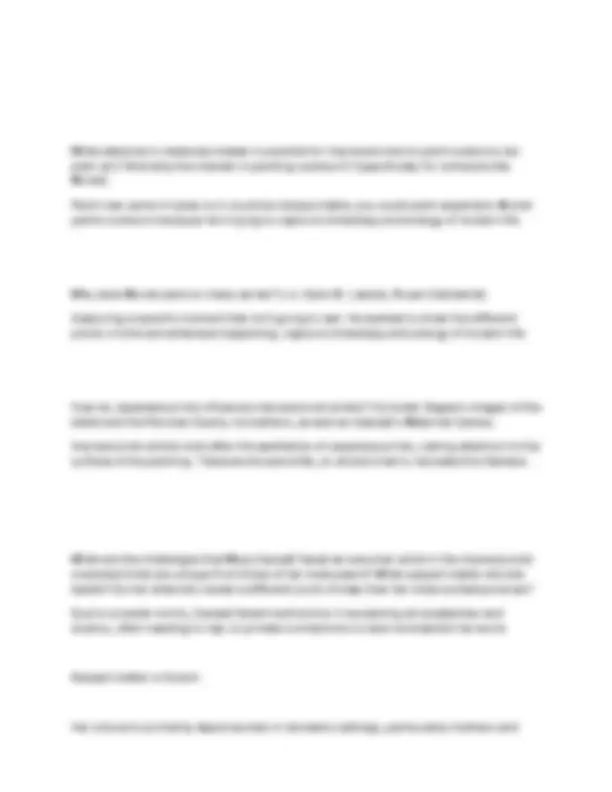





Study with the several resources on Docsity

Earn points by helping other students or get them with a premium plan


Prepare for your exams
Study with the several resources on Docsity

Earn points to download
Earn points by helping other students or get them with a premium plan
Community
Ask the community for help and clear up your study doubts
Discover the best universities in your country according to Docsity users
Free resources
Download our free guides on studying techniques, anxiety management strategies, and thesis advice from Docsity tutors
REALISM & EARLY PHOTOGRAPHY IMPRESSIONISM QUESTIONS AND CORRECT ANSWERS!!
Typology: Exams
1 / 6

This page cannot be seen from the preview
Don't miss anything!




Realism is often considered the beginning of Modern Art - why? Why are both Realism and Impressionism considered avant-garde? What are the reacting to/rejecting?
Advanced guard: experimental and cutting edge work that pushes the boundary of convention. In response to social changes that are transforming society; the modern cities, industrial and urban growth. But it's also showing the struggles of the poor and the elevated middle class.
Impressionist works were shocking and went past convention as well, and shows anti academic work just like realism.
A lot of painters are rejected, and in response to this they held the first Impressionist Exhibition. There are depictions of real, and modern life in realism and impressionists, shows suburban leisure and real life. Impressionists continue that look of modern day of realism and add they add new flicky and brushy side to it.
What are the artistic goals of the Realists? Of the Impressionists? What links the Realist painters and the Impressionist painters? What separates them? Does Impressionism have distinct goals from Realism?
Impressionists were focused on capturing the fleeting, momentary, protectory. Quality of light on objects, weather and atmospheric effects, brushy and patchy strokes to create a sense of spontaneity. Like realists, they were anti academic and works were shocking to contemporary audiences. Depicts modern life still of suburban leisure or urban city. Paint now comes in tubes and can travel.
Realists goals were artistic responses to rapid social changes transforming modern society; modern city was source of inspo, surge of industrial and urban growth, political backdrop because of the Revolution of 1848. Focuses more on the here and now, embracing the modern world, gritty and real. Sights and experiences of everyday life and truth. Move away from the exotic of romanticism, and of mythology. Had more of an impact with the political backdrop happening. First modern art movement; experimental and innovated pushing boundaries of convention.
What political event effectively gives rise to Realism? Think about how the political identity of Realism affects subject matter & style. Consider specifically the case of Courbet and his Stonebreakers and The Burial at Ornans. What did critics - and Parisian citizens! - object to in Ornans?
The Revolution of 1848 in France which over throwed the July Monarchy of King Louis-Philippe with Napoleon the 3rd being installed later. The political identity of Realism affects subject matter & style in the way that this style is a rejection to tradition and pieces depict the real daily lives of people who are not middle class, but the working class and peasants. The Stonebreakers is a raw painting showing nothing idealized, but real people working. Gritty and real.
People objected how religion is treated because the church figures are at the same height in the painting as everyone else. They aren't portrayed in the most idealized way, and there's just the hole in the ground showing 'you're dead'. There's no hope for salvation, or the net of safety like heaven. Gritty moment- death, all figures being equal. No suggestion of afterlife- just death.
How does the trend away from Romanticism towards more realistic imagery affect the subject and style of art? How is Daumier's Rue Transnonian the epitome of a Realist work of art? (think: subject matter, style, medium, etc.) What has happened in this scene? How do we as viewers react?
Subject and style are more raw and 'realistic' wheras romanticism was very disturbing and horror shown on purpose. Realistic imagery shows events as they are- things that really happen - not disturbing, grotesque works of art that are only meant to shock people with horror. But instead these are events that really happen to people. These workers were slain, which gives it a deeper meaning and feel to the people who saw Daumier's Rue Transnonian in the newspaper. This disturbing reality of innocent people being killed was a real event taking place. There is this gritty rawness of average people being slain- not a story or mythical event. Daumier's Rue Transnonian was meant to attack the French king and wealthy officials.
As the viewer we are seeing the horrible aftermath of this event; it is awful, and makes your stomach kind of churn. It makes me angry as well knowing that innocent people were slain. Someone in this time may have seen this and felt the same way, which would lead to a push or protest against the French king and wealthy officials.
In this scene innocent people are killed because of a workers uprising in Lyon were a
The work of Manet was considered shocking for its time - why? Think specifically about Manet's Luncheon on the Grass and why it is consigned to the Salon des Refusés as well as his Olympia. What were audiences used to seeing at the Salon? But is Manet abandoning all traditional imagery?
The audiences did not like that it depicted a prostituted and the men were themselves. It was showing the reality of what French men were doing, and they didn't want to accept that reality and saw it as up surd. Audiences were used to seeing the nymphs, naked ladies removed from reality. Not the reality of people's actions. No, he is not abandoning all traditional imagery as he winks at a traditional Renaissance print which proves that he knows the traditions, but is presenting it in a realistic way at the audience
What are the key stylistic characteristics of the Impressionist movement? What are typical Impressionist subjects? [be able to discuss the breadth of Impressionism, i.e. Monet, Degas, and Caillebotte are all Impressionists - how does each fit into the movement?]
Stylistic Characteristics: Impressionists were focused on capturing the fleeting, momentary, protectory. Quality of light on objects, weather and atmospheric effects, brushy and patchy strokes to create a sense of spontaneity. Like realists, they were anti academic and works were shocking to contemporary audiences. Depicts modern life still of suburban leisure or urban city. In the moment scenes of modern life.
Claude Monet: famous for his series paintings SHOWING changing qualities of light on water.
Edgar Degas:
focused on capturing movement in human figures, particularly dancers and racehorses, angles.
Gustave Caillebotte:
modern Paris, particularly its streets and architecture, often incorporating a unique perspective and a more realistic style compared to other Impressionists.
What advance in materials makes it possible for Impressionists to paint outdoors (en plein air)? And why the interest in painting outdoors? (specifically for someone like Monet)
Paint now came in tubes so it could be transportable; you could paint anywhere. Monet paints outdoors because he's trying to capture immediacy and energy of modern life.
Why does Monet paint so many series? (i.e. Gare St. Lazare, Rouen Cathedral)
Capturing a specific moment that isn't going to last. He wanted to show the different points in time and what was happening; capture immediacy and energy of modern life.
How do Japanese prints influence Impressionist artists? Consider Degas's images of the ballet and the Parisian Opera, his bathers, as well as Cassatt's Maternal Caress.
Impressionist artists took after the aesthetics of Japanese prints, calling attention to the surface of the painting. These works were flat, so artists tried to recreate this flatness.
What are the challenges that Mary Cassatt faced as a woman artist in the Impressionist movement that are unique from those of her male peers? What subject matter did she tackle? Do her artworks reveal a different point of view than her male contemporaries?
Due to societal norms, Cassatt faced restrictions in accessing art academies and studios, often needing to rely on private connections to learn and exhibit her work.
Subject matter criticism:
Her choice to primarily depict women in domestic settings, particularly mothers and